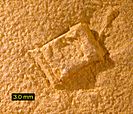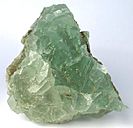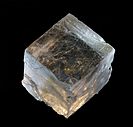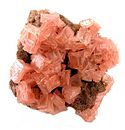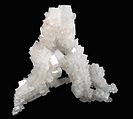Halite facts for kids
Quick facts for kids Halite |
|
|---|---|

Halite from the Wieliczka salt mine, Małopolskie, Poland
|
|
| General | |
| Category | Halide mineral |
| Formula (repeating unit) |
NaCl |
| Strunz classification | 3.AA.20 |
| Crystal symmetry | Fm3m |
| Unit cell | a = 5.6404(1) Å; Z = 4 |
| Identification | |
| Formula mass | 58.433 g/mol |
| Color | Colorless or white when pure. Impurities produce any color but usually yellow, gray, black, brown, red (Depends on isotopes and purity for various colours) |
| Crystal habit | Predominantly cubes and in massive sedimentary beds, but also granular, fibrous and compact |
| Crystal system | Cubic |
| Cleavage | Perfect {001}, three directions cubic |
| Fracture | Conchoidal |
| Tenacity | Brittle |
| Mohs scale hardness | 2.0–2.5 |
| Luster | Vitreous |
| Streak | White |
| Diaphaneity | Transparent to Translucent |
| Specific gravity | 2.17 |
| Optical properties | Isotropic |
| Refractive index | n = 1.544 |
| Melting point | 800.7 °C |
| Solubility | Water-soluble |
| Other characteristics | Salty flavor, may be fluorescent |
Halite, more commonly known as rock salt, is a type of salt. It is the natural, mineral form of sodium chloride (NaCl), the same salt you use for cooking! Halite is famous for forming cube-shaped crystals.
While pure halite is colorless or white, it can come in many amazing colors. It can be light blue, dark blue, purple, pink, red, orange, yellow, or gray. These colors are caused by tiny impurities or other interesting things happening inside the crystals. Halite is often found with other minerals that form when salty water evaporates, like sulfates and borates. The name halite comes from the Ancient Greek word for salt, háls.
Contents
Where Can You Find Halite?

Halite usually forms in sedimentary rocks when seawater or salty lake water evaporates, leaving the salt behind. When large bodies of water like enclosed lakes or seas dry up, they can leave behind huge beds of salt. These salt beds can be hundreds of meters thick and stretch over very large areas.
You can see halite forming today in very dry places where water evaporates faster than it rains. A great example is the salt flats of Badwater Basin in Death Valley National Park.
Underground Salt Deposits
In the United States and Canada, there are massive underground salt beds. They stretch from western New York, through parts of Ontario, and under much of the Michigan Basin. There are also large deposits in Ohio, Kansas, and New Mexico. The Khewra salt mine near Islamabad, Pakistan, is another huge deposit of halite.
Sometimes, these underground salt beds get squeezed by the weight of the rocks above them. This pressure can push the salt up into giant, pillar-like shapes called salt domes. Salt domes are common along the coast of the Gulf of Mexico in Texas and Louisiana. They are often found near petroleum (oil) deposits.
Unique Halite Formations
Halite can form in some very unusual and beautiful ways.
- Hopper Crystals: These look like skeleton versions of salt cubes. The edges of the crystal grow much faster than the center, creating hollow, stairstep shapes on each face.
- Halite Flowers: In some dry caves, like those in Australia's Nullarbor Plain, rare, curling fibers of halite form. These delicate structures look like flowers.
- Salt Glaciers: In dry parts of Iran, salt can break through the Earth's surface on mountains and flow downhill, just like a slow-moving glacier of ice.
How Is Salt Mined?
The world's largest underground salt mine is the Sifto Salt Mine, located half a kilometer under Lake Huron in Ontario, Canada. It produces over 7 million tons of rock salt every year!
Miners there use a method called room and pillar mining. They carve out large areas, or "rooms," of salt, but leave behind large "pillars" of salt to support the roof and keep the mine stable. In the United Kingdom, one of the largest salt mines is in Winsford, Cheshire, which produces about one million tonnes of salt each year.
How Do We Use Rock Salt?
Salt is a very important part of our daily lives. We use it in many different ways.
In the Kitchen
Salt is a key ingredient in cooking. It enhances the flavor of food and is used to cure (preserve) foods like bacon and fish. For thousands of years, people have used salt to make food last longer. You can grind large pieces of rock salt in a salt mill or sprinkle it on food from a shaker.
Keeping Roads Safe in Winter
Halite is used to manage ice on roads and sidewalks. When you put salt on ice, it creates a saltwater solution called brine. Brine freezes at a lower temperature than pure water. This effect is called freezing-point depression.
Because of this, sprinkling salt on an icy sidewalk can cause the ice to melt, even if the temperature is below 0 °C (32 °F). Cities often spread a mix of sand and salt on roads after a snowstorm to help cars get better traction and to melt the ice.
Other Important Uses
- Farming: Rock salt is sometimes used in agriculture. For example, it can be used to control the growth of certain weeds.
- Cleaning: The rough texture of salt makes it a useful household cleaner for scrubbing away grease or stains.
- History: Salt used to be so valuable that it was used as a form of money in some ancient cultures. In ancient times, salt was sometimes spread over the land of a defeated enemy to show power and make the soil unusable for farming.
Gallery
-
Pebbles made of halite from the coast of the Dead Sea in Israel
See also
 In Spanish: Halita para niños
In Spanish: Halita para niños
- Coarse salt (edible)
- Salt tectonics
- Grozon coal and saltworks



